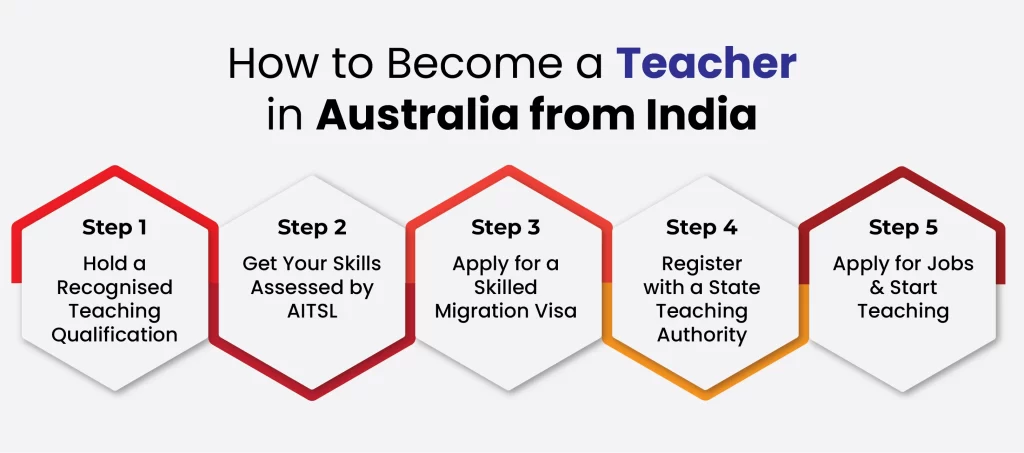Australia is currently facing a critical shortage of qualified teachers, especially in math, science, and early childhood education. If you’re a trained teacher looking to move abroad, now is the best time to explore teaching jobs in Australia!
Right now, there are over 12,000 teaching jobs listed on SEEK, one of Australia’s top job sites and new ones are popping up every single day! These jobs aren’t just in the big cities. You’ll find roles across metro, regional, and rural areas, with salaries ranging from AUD 78,801 to 116,894 per year, depending on where you’re working and how experienced you are.
Table Of Content
1Are Teachers In Demand in Australia?2Types of Teaching Jobs in Australia3Requirements for Teaching Jobs in Australia4How to Become a Teacher in Australia from India5Teaching Jobs in Australia for Indian Teachers6Salary for Teachers in Australia7Teaching Jobs in Australia with Visa Sponsorship8The Bottom Line9Frequently Asked Questions
So whether you’re just starting your career or already have years of experience, there’s never been a better time to look into teaching jobs in Australia!
Are Teachers In Demand in Australia?
Yes, teachers are definitely in demand in Australia right now. With the country facing a significant shortage of both primary and secondary school teachers, opportunities in the education sector are expected to grow rapidly, especially for professionals listed under the ANZSCO teacher occupation codes.
Teachers are essential to Australia’s growing economy, and projections show a 9.4% job growth in the education sector over the next three years. By 2026, it’s estimated there will be around 25,800 teaching job vacancies across the country.
Types of Teaching Jobs in Australia
Australia offers a variety of teaching roles across various educational settings, giving away to different age groups, subject specialisations, and student needs. Below is an overview of the main types of teaching jobs in Australia:
1. Early Childhood Teachers
Early Childhood Teachers work in childcare centres, kindergartens, and preschools, focusing on children aged 0 to 5 years. They use play-based learning and structured activities to support social, emotional, and cognitive development.
2. Primary School Teachers
Primary teachers educate children from Foundation (Prep) to Year 6 and are responsible for teaching core subjects such as English, Maths, Science, and Humanities. They play a key role in shaping a child’s foundational knowledge, skills, and social development.
3. Secondary School Teachers
These teachers work with students from Year 7 to Year 12, typically specialising in specific subjects such as Mathematics, Biology, English, or History. They help prepare students for final examinations, tertiary education, or vocational pathways.
4. Special Education Teachers
Special Education Teachers support students with disabilities, learning difficulties, or behavioural challenges. They create special education plans (IEPs) and adapt classroom strategies to meet individual needs.
5. Relief / Casual Teachers (CRT)
Casual Relief Teachers temporarily replace regular teachers who are on leave or attending training. They may work in various schools, often at short notice, and must adapt quickly to new environments. This role offers flexibility and is ideal for those seeking part-time or diverse teaching experiences.
6. Education Support / Teacher Aides
Teacher Aides work alongside classroom teachers to provide additional support to students, particularly those with special needs or learning difficulties. Their duties may include helping with reading, classroom management, or assisting during lessons.
7. Vocational Education and Training (VET) Teachers
VET teachers deliver job-focused education in TAFEs and private training organisations, preparing students for specific trades or careers. Courses may cover areas like hospitality, construction, IT, or aged care.
8. University Lecturers / Tutors
Lecturers and tutors work in universities and other higher education institutions, often specialising in academic or research-based subjects. They deliver lectures, conduct seminars, assess students, and publish research.
9. Language Teachers (ESL & LOTE)
Language teachers focus on teaching English as a Second Language (ESL) or Languages Other Than English (LOTE) like Mandarin, French, or Japanese. They work in schools, adult education centres, and migrant language programs.
10. Remote / Regional Teaching Roles
Teachers in rural and remote communities often face unique challenges, such as limited resources and isolation, but also receive additional support or incentives. These roles are critical in making sure that education is equitable across all areas of Australia, including Indigenous communities.
Requirements for Teaching Jobs in Australia
Teaching jobs are in demand jobs in Australia across early childhood, primary, and secondary levels. Whether you’re a local graduate or an overseas-trained teacher, you must meet specific academic, registration, and immigration criteria to work legally in Australian schools. Below is a simplified guide to help you understand the key requirements for teaching jobs in Australia:
Recognised Teaching Qualification
To apply for teaching jobs in Australia, you need a Bachelor of Education or a postgraduate teaching qualification (e.g., Master of Teaching). If your degree is from outside Australia, it must be assessed for equivalency by AITSL to ensure it meets Australian standards.
Teacher Registration (Mandatory)
All teachers must be registered with the relevant state or territory body, such as VIT, NESA, or TRB. You may begin with provisional registration and later progress to full registration after meeting teaching standards and gaining classroom experience.
English Language Proficiency
For international applicants, it is important to demonstrate the ielts requirement for teachers in australia. For skills assessment of overseas-trained teachers, AITSL only accepts the Academic IELTS ( minimum score of overall 7.5). Other tests like PTE, TOEFL, or Cambridge are not accepted.
Working With Children Check (WWCC)
A valid Working With Children Check is mandatory before starting any teaching role. This clearance confirms you’re legally allowed to work with minors and applies to both public and private school sectors.
Skills Assessment (For Migrants)
Migrants must undergo a skills assessment by AITSL to qualify for teaching jobs in Australia under skilled migration visas. This includes verifying your qualification, teaching practice hours, and English skills.
Visa to Work in Australia
To legally work in Australia, you’ll need a suitable visa such as the Skilled Independent (subclass 189) or TSS (subclass 482). Some teachers may enter on a Working Holiday Visa for short-term roles, while others may be sponsored by an employer.
Professional Experience / Internship
A minimum number of supervised teaching hours (usually 45+ days) is required. Australian schools value practical classroom experience, so this is a key factor when applying for teaching jobs in Australia.
Continuing Professional Development (CPD)
Once registered, teachers must complete ongoing professional development each year to maintain their teaching licence. This ensures educators stay current with curriculum updates and modern teaching practices.
How to Become a Teacher in Australia from India
If you’re a qualified teacher in India looking to take your career overseas, teaching jobs in Australia can offer an exciting and fulfilling opportunity. With a strong demand for skilled educators across early childhood, primary, and secondary levels, Australia welcomes internationally trained teachers who meet its professional standards.

Here’s a step-by-step guide on how to become a teacher in Australia from India:
Step 1: Hold a Recognised Teaching Qualification
You must have a 4-year Bachelor of Education or a 3-year degree plus a 1–2 year teaching qualification (like a B.Ed or M.Ed). Your qualification must align with Australian standards.
Step 2: Get Your Skills Assessed by AITSL
Apply for a skills assessment through the Australian Institute for Teaching and School Leadership (AITSL)
Requirements include:
- Recognised teaching qualification
- At least 45 days of supervised teaching practice
- Academic IELTS only (Overall 7.5; 8.0 in Speaking & Listening, 7.0 in Reading & Writing)
Step 3: Apply for a Skilled Migration Visa
If your occupation (e.g., Secondary School Teacher, Early Childhood Teacher) is on the Skilled Occupation List, you may apply under:
- Subclass 189 (Independent)
- Subclass 190 (State Nominated)
- Subclass 491 (Regional)
You’ll need to submit an Expression of Interest (EOI) via SkillSelect.
Step 4: Register with a State Teaching Authority
Once in Australia, you must register with the relevant state or territory teacher registration board (e.g., VIT for Victoria, NESA for NSW). This may involve additional checks like the Working With Children Check.
Step 5: Apply for Jobs & Start Teaching
After registration, you can apply for teaching jobs in public or private schools across Australia. You may also gain local experience through casual or relief teaching first.
Teaching Jobs in Australia for Indian Teachers
Australia has a growing demand for qualified teachers, and Indian educators with the right qualifications and experience have great opportunities to build a successful career there. Whether you’re an early childhood educator or a secondary school teacher, teaching jobs in Australia for Indian teachers are accessible through the skilled migration pathway.
Below are some teaching jobs in Australia along with their ANZSCO codes for Indian teachers:
| Job Title | ANZSCO Code |
|---|---|
| Early Childhood (Pre-Primary) Teacher | 241111 |
| Primary School Teacher | 241213 |
| Middle School Teacher (if applicable) | 241311 |
| Secondary School Teacher | 241411 |
| Special Needs Teacher | 241511 |
| Teacher of the Hearing Impaired | 241512 |
| Teacher of the Sight Impaired | 241513 |
| Special Education Teachers (Other) | 241599 |
Salary for Teachers in Australia
Teaching jobs in Australia not only offer a fulfilling career but also provide competitive salaries and strong job security. Teacher pay varies depending on qualifications, experience, and the state or territory in which you work. Whether you’re just starting out or bringing years of classroom experience, Australia rewards educators with attractive pay scales, professional growth opportunities, and additional benefits that are especially for those willing to work in regional or high-demand areas.
The average salary for teachers in Australia is given by:
| Position | Typical Annual Salary Range (AUD) | Notes |
|---|---|---|
| Early Childhood Teacher | $70,000 – $90,000 | Higher in NSW; starting salaries around $85,000 in some states |
| Primary School Teacher | $73,500 – $122,000 | Varies by state and experience; NSW/VIC/WA upper end above $110,000 |
| Secondary School Teacher | $75,000 – $128,000 | NSW/WA upper end above $120,000; average nationally ~$100,000 |
| Special Education Teacher | $80,000 – $126,000 | Higher with experience and in some states |
| Relief / Casual Teacher | $420 – $660 per day | Daily rates; varies by state and experience |
| Vocational Education Teacher | $80,000 – $120,000 | TAFE and VET sector; varies by institution |
*Here is a final, up-to-date table of teacher salaries in Australia for 2025, based on the latest data across states and sectors*
Teaching Jobs in Australia with Visa Sponsorship
Hundreds of sponsored teaching roles are currently open across Australia, especially in early childhood and primary education. Secondary teacher roles (e.g., STEM, Special Education) also have demand, depending on region and subject area.
Top States Offering Sponsorship:
- New South Wales (NSW)
- Victoria (VIC)
- Queensland (QLD)
- Western Australia (WA)
Current Opportunities (as of June 2025)
- SEEK, Indeed, and Jora feature hundreds of active visa-sponsored listings
- Catholic Education Western Australia (CEWA) is sponsoring early childhood and primary teachers in remote areas
- ACT Education Directorate and other state education departments are hiring teachers for both urban and regional schools
Note: Sponsorship availability, requirements, and benefits can change based on location, employer, and government policy. Always check the specific job listing and employer for current details.
The Bottom Line
Australia offers incredible opportunities for qualified teachers, especially those from India and other countries seeking global career growth. With a growing demand across early childhood, primary, secondary, and special education sectors, teaching jobs in Australia are not only plentiful but also come with competitive salaries, long-term career security, and, in many cases, visa sponsorship support.
Whether you’re just beginning your teaching journey or bringing years of experience to the table, now is the perfect time to take the next step. From meeting AITSL requirements and securing a skilled visa to finding roles in regional communities or major cities in Australia welcomes dedicated educators ready to make a difference.
Start your teaching career in Australia today and become part of the Australia immigration system that truly values the power of education.





